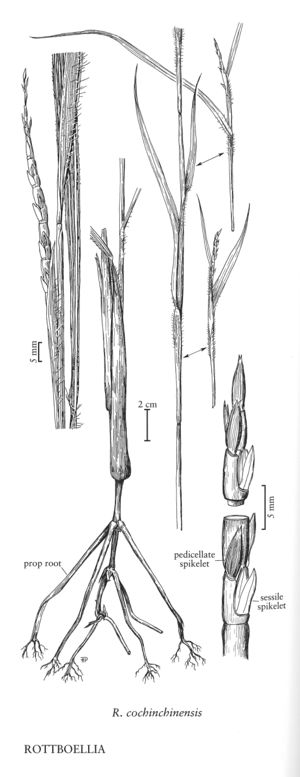Difference between revisions of "Rottboellia cochinchinensis"
FNA>Volume Importer |
imported>Volume Importer |
||
| (3 intermediate revisions by 2 users not shown) | |||
| Line 4: | Line 4: | ||
|publications= | |publications= | ||
|common_names=Itchgrass | |common_names=Itchgrass | ||
| + | |special_status={{Treatment/ID/Special_status | ||
| + | |code=I | ||
| + | |label=Introduced | ||
| + | }} | ||
|basionyms= | |basionyms= | ||
|synonyms={{Treatment/ID/Synonym | |synonyms={{Treatment/ID/Synonym | ||
| Line 46: | Line 50: | ||
|publication title= | |publication title= | ||
|publication year= | |publication year= | ||
| − | |special status= | + | |special status=Introduced |
| − | |source xml=https:// | + | |source xml=https://bitbucket.org/aafc-mbb/fna-data-curation/src/200273ad09963decb8fc72550212de541d86569d/coarse_grained_fna_xml/V25/V25_1651.xml |
|subfamily=Poaceae subfam. Panicoideae | |subfamily=Poaceae subfam. Panicoideae | ||
|tribe=Poaceae tribe Andropogoneae | |tribe=Poaceae tribe Andropogoneae | ||
Latest revision as of 17:57, 11 May 2021
Culms developing prop roots from the lower nodes. Sheaths with 1-3 mm, stiff, papillose-based hairs; ligules 1-1.3 mm, light brown; blades (9)20-50(60) cm long, 10-20(25) mm wide, glabrous abaxially, adaxial surfaces mostly sparsely pubes¬cent, densely pubescent behind the ligules, hairs papillose-based. Rames (3)6-15 cm long, 2-4 mm wide; internodes 6-12 mm. Sessile spikelets: lower glumes 3.5-7 mm long, 1.4-2 mm wide, convex to flat, 11-13(15)-veined, apices bifid; upper glumes 5-6.2 mm, navicular, almost completely enclosing the florets, (13) 15-17-veined; anthers of lower florets 2.2-2.3 mm; anthers of upper florets 1.2-2.1 mm; stigmas purple. Pedicels 3-6.5 mm long, 1.5-2.2 mm wide, flat. Pedicellate spikelets 3-8 mm, sterile. Caryopses 3-4 mm long, 2-2.2 mm wide. 2n = 20, 40.
Distribution
Puerto Rico, Ga., Tex., La., N.C., Ark., Miss., Ind., Fla.
Discussion
Rottboellia cochinchinensis is a native of southeast Asia. The species is considered one of the world's worst weeds, and is classified as a noxious weed by the U.S. Department of Agriculture. It is established in the southeastern United States, and has been reported from scattered locations elsewhere in the contiguous United States. In Africa, it is controlled by tillage or by fire, followed by shallow, then deep, plowing (Hall and Patterson 1992). 'Itchgrass' aptly describes the effects of the hairs on the skin.
Selected References
None.
